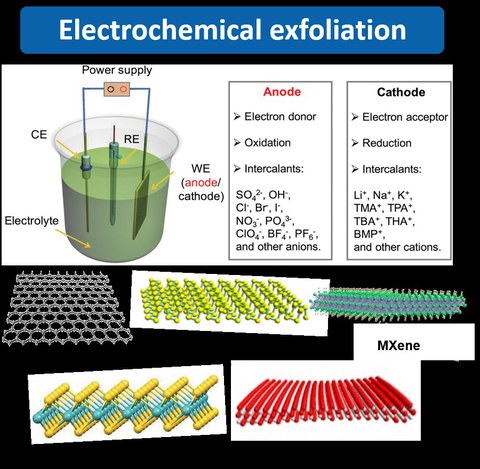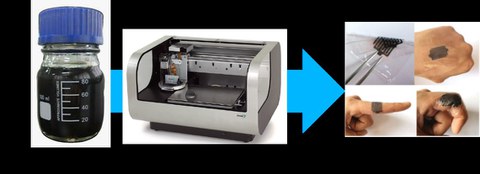2D Materials funtionalization and innovation
Research Area I: Emerging Two Dimensional Materials
- Electrochemical and Chemical Exfoliation
2D materials are important building blocks for the next generation of electronic, optoelectronic and energy-related devices due to their excellent chemical and physical properties. To this end, scalable synthesis of 2D materials with high purity and specific functionalities represents a key to advancing fundamental studies and industrial applications. Among different synthetic protocols, electrochemical exfoliation of layered materials is a promising approach that offers high yield, remarkable efficiency, low cost, simple instrumentation, and excellent up‐scalability. Remarkably, playing with controlled electrochemistry enables functionalization and tunable material properties and increases the material diversities from graphene to a broad spectrum of 2D semiconductors. In our group, we explore the controlled synthesis, fundamental physical/chemical properties as well as applications of emerging 2D materials such as black phosphorous, indium(III) selenide, MXene, and transition metal dichalcogenides via electrochemical and chemical exfoliation. We aim to establish roubust electro-chemical exfoliation methodologies for the in-situ functionalization, enlabling the enhanced processability and functionaliaty of 2D materials.
Selected Publications:
1- A Delamination Strategy for Thinly Layered Defect-Free High-Mobility Black Phosphorus Flakes. Angew. Chem. Int. Ed. 2018, 57 (17), 4677-4681
2- Fluoride-Free Synthesis of Two-Dimensional Titanium Carbide (MXene) Using A Binary Aqueous System. Angew. Chem. Int. Ed. 2018, 130 (47), 15717-15721.
3- Ultrafast Electrochemical Synthesis of Defect-Free In2Se3 Flakes for Large-Area Optoelectronics. Adv. Mater. 2020, 32 (8), 1907244.
4- Emerging 2D Materials Produced via Electrochemistry. Adv. Mater. 2020, 32 (10), 1907857
Patent and patent applications:
1- Two-dimensional carbon materials prepared by electrochemical exfoliation, WO2015158711A1
2- Method for producing a layered (semi-)conductive material, EP3153605B1, WO2017050689A1
3- Method for the synthesis of MXenes, MXene nanosheets and their use. EP20191753.1
- Functionalization of 2D materials
Most of 2D materials such as transition metal dichalcogenides, 2D metals, transition metal carbides/nitrides suffer from environmental stability. On the other hand, their physical properties, such as bandgaps and charge carrier mobilities, require to be tailored in order to fulfill the targeted applications. In our group, we are using different chemical functionalization strategies to achieve tunable physical properties of 2D materials. Moreover, we aim to develop 2D materials-based inks for large-area fabrication of electronic, optoelectronic and energy-storage devices.
Selected publications:
- Electrochemically Exfoliated High-Quality 2H-MoS2 for Multiflake Thin Film Flexible Biosensors. Small 2019, 15 (23), 1901265.
- Efficient Coupling of Nanoparticles to Electrochemically Exfoliated Graphene. J. Am. Chem. Soc 2015, 137 (16), 5576-5581.
- Alternating Stacked Graphene-Conducting Polymer Compact Films with Ultrahigh Areal and Volumetric Capacitances for High-Energy Micro-Supercapacitors. Adv. Mater. 2015, 27 (27), 4054-4061.
Patent and patent applications:
Process for the preparation of a functionalized semiconductor or conductor material and its use, DE102017223892A1, WO2019129573A2
Research Area II: 2D materials inks and printable devices
- Large-scale production and processability
The first step towards commercialization and industrialization of 2D materials in different areas such as electronics and energy harnessing is to achieve reliable large-scale production and processability of these materials. For this purpose, we have developed a continuous flow process technique for the electrochemical exfoliation of 2D materials. On the other hand, by in-situ functionalization of 2D materials during the the exfoliation process, we can improve the processability of these materials for various applications.
- Printing technologies
The next step towards real practice is the fabrication of 2D materials with the state-of-the-art printing technologies, which could be further adapted into roll-to-roll processes. To this end, we develop functional inks and pastes for different printing technologies like inkjet printing for the fabrication of different energy and electronic devices such as flexible micro-supercapacitors.
Research Area III: Environmental 2D based foam, coating, and composites
We are developing 2D material based foams, composites, and coatings for environmental applications such as water/air purification, anticorrosion coating, and thermal management. In this regard, we collaborate with top European industries such as BASF, Lufthansa Technik, Barpimo, Polymem, and Tecnalia. Together with Barpimo, we are developing graphene-based waterborne anticorrosion coating paints for automotive industries. In another project with Lufthansa Technik, we are developing self-cleaning graphene-based foams for aircraft's air filtration system. In collaboration with our colleagues in Kiel University and Tecnalia, we are developing different 2D material based foams for desalination technologies for the water purification.
Research Area IV: Development of Energy Storage Devices
With the rapid development of power-demanding smart devices such as wearable electronics and the Internet of Things (IoT), functional energy sources with high energy and power densities, operational safety, long-term stability, in addition to mechanical flexibility, lightweight, thin thickness, and low cost are in urgent need. Therein, we are developing thin and flexible energy storage devices such as batteries and supercapacitors for wearable applications. Within this area, we collaborate with different industries in the fields of energy, wearable electronics, and smart cloth/textiles. For example, we are collaborating with InteractiveWear AG and E-COOLINE, who are active in the area of wearable electronics and thermo-regulator clothes, respectively. We are developing a power system based on flexible graphene supercapacitors to power up the environmental sensors (temperature, humidity, and barometric pressure sensors) within a thermo-regulator jacket.
Patent and Patent applications:
- Bismut-Ionen-Akkumulator. DE 102020101890.8.


